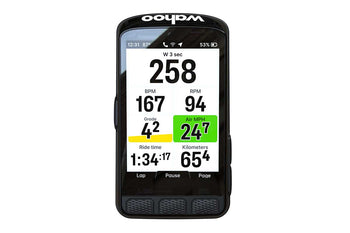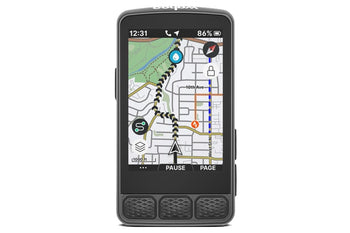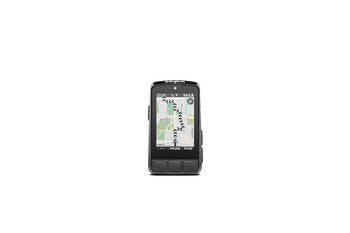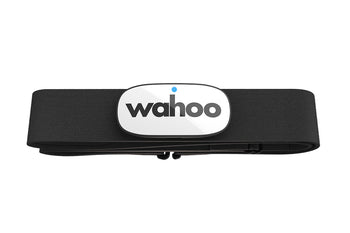

What do the ELEMNT ACE, ROAM 3 and BOLT 3 GPS cycle computers have in common?
With the release of the Wahoo ELEMNT ROAM 3 and BOLT 3 comes a move to the Wahoo app for all things setup, customisation, route management and data access. These, and the ACE, will sync with this app, rather than the ELEMNT app used by the older models.
Wahoo has essentially streamlined the three devices, whilst still ensuring each has a specific purpose. The latest ROAM and BOLT computers now feature the same software and display platform as the ACE, and, as with the last editions, they all connect to the app, sensors and Wahoo KICKR smart trainers via ANT+ and Bluetooth Smart sensors, and all pair with third-party apps such as Strava, Ride with GPS, TrainerRoad and more. Essentially, you get the same user interface on all three now, and the BOLT 3 and ROAM 3 definitely have a slicker aesthetic than their predecessors. All the screens, although different sizes, are made up of 16 million colours.
Some features are shared between the ELEMNT ACE and the ROAM 3 — a touchscreen and an audio speaker — whereas the BOLT has only button functionality (not necessarily a negative; a non-touchscreen device may seem outdated but in the winter it is not often you want to take your gloves off to use your bike computer) and a single volume beeper. All the ELEMNT computers have three nice big buttons on the front for easy pressing.
Wahoo GPS Computers at a Glance
Dimensions, weight and design
The ELEMNT ACE is the biggest device of the three at 125 x 71 x 20mm / 4.9 x 2.75 x 0.78” (also, unsurprisingly, the heaviest at 208 grams), and boasts a 9.7cm (3.8”) diagonal screen. In fact, it is bigger than the rival Garmin Edge 1050 unit.

Both a fair bit smaller, the ELEMNT ROAM 3 has a 7.1cm (2.8") colour screen, whilst the ELEMNT BOLT 3 has a 5.84cm (2.3") colour screen. And because the screen is smaller, the BOLT naturally weighs less — 25 grams less, to be precise (84 grams v 109 grams), and is easily the most compact unit (83mm x 47mm x 24mm v 96mm x 53mm x 24mm).

The BOLT has always been the ‘aero one’, optimised to reduce drag, and was wind tunnel tested as part of its design process. Wahoo claimed the original BOLT offered 50% less drag (air resistance), saving you 1.5 watts when fitted with Wahoo's aero out front mount for extra wind slicing advantage. Although this latest model has no specific drag-reducing claims, it’s still sold as providing an aerodynamic advantage.
Both the ROAM and BOLT have increased in size compared to the last editions, and have a slicker, more modern look that’s definitely more aesthetically pleasing.



ELEMNT ACE Wind Sensor
One thing that’s completely unique to the ELEMNT ACE is the wind sensor: a front-facing air pressure sensor that's designed to help you understand the relative air resistance. Essentially, you’ll be able to see the effect a headwind or tailwind is having on your ride, and delve into the impact of sitting on the front or tucking in behind another rider. Your GPS head unit will display the effects in real time and you’ll be able to do some post-ride analysis in the Wahoo app, too. ELEMNT ACE is the first of Wahoo’s bike computers to feature the sensor.
Battery life and charging
All three devices have USB-C charging and a lithium-ion battery, which is now the norm across many electronics. The ACE offers up to 30 hours of battery life, the ROAM up to 25 hours, and the BOLT up to 15 hours. As you would expect, the amount of battery life you actually get depends on what features you are using, for example the screen backlight, LEDs, voice commands or navigation.
Screen
The ACE, ROAM and BOLT all feature an extremely vibrant, anti-reflective colour screen made up of 16 million colours, and have exceptional clarity, which is great as it makes following a route or reading data off the screen very easy, even at speed or over rough surfaces. If navigation is an important feature, you’ll particularly appreciate the larger screens of the ACE and ROAM.
These bigger units also have a touchscreen, which is new to the ROAM computer. There are often mixed opinions about touchscreens but, whether you’re a fan or not, you now get pinch, zoom and swipe functionality. The screens are meant to be glove compatible (although maybe not with bulky winter gloves). It’s nice that they’re not purely touchscreen though, and both units have the same three, easy-press buttons along the bottom, in common with the BOLT.


LED indicators and sound
They may have been a popular feature on the older ROAM and BOLT models, but the LED indicators that could be seen along the side and top edges of the ROAM and the top of the BOLT are now gone. They could be customised to light up as a visual indicator of upcoming turns and segments, or during training intervals, but Wahoo has made the decision to remove them. The ACE never had the LEDs so the other two computers have simply been brought more in line with this one.
What you can do is set up all of the units to include LEDs on the screen itself — the ACE and ROAM on the left side and top, and the BOLT on the top only, so they haven’t been completely ignored, just changed.
The introduction of an audio speaker on the ACE and ROAM with variable volume control (including mute) means you can get voice commands for alerts and notifications, whereas the BOLT has a single volume beeper. There’s even a digital bell chime that’s great for warning pedestrians and other cyclists of your approach.
Wahoo Accessories & Sensors

Speed Sensor
If you ride indoors on a non-smart turbo trainer or set of rollers, a speed sensor becomes a requirement for recording your speed and distance. Riding through remote or mountainous areas or under dense tree cover can affect satellite accuracy and a speed sensor will continue to provide distance and speed data if your signal becomes weak.

Cadence Sensor
A cadence sensor is beneficial if you are following a training plan, which requires you to pedal at different cadences, or if you are new to cycling and getting used to pedalling at 80–100 RPM. The sensor will send the information to the head unit when you ride indoors or out. However, if your bike is fitted with power-enabled pedals or a power meter chainset, this will automatically measure your cadence and pair with the Wahoo device.

Heart Rate Monitor
Using a heart rate monitor provides valuable insight into effort if you are training outdoors and don't use a power meter or power pedals. It helps track fitness, detect fatigue and calorie burn accurately. While power shows output, heart rate reveals how your body responds, making training more effective.
Which Wahoo ELEMNT cycling computer is best for my type of riding?
The three Wahoo ELEMNT units have certainly become more streamlined in terms of their features but there are some significant differences. If you are still undecided, consider the type of riding you do, the features you would like to prioritise and, of course, your budget.
If navigational features are top of your list of priorities — maybe you’re into bike-packing, multi-day adventures or just really long rides — you should look at the ELEMNT ACE. It features the biggest screen, a large storage capacity and the best battery life. It is the most expensive of the three and is big, perhaps a little cumbersome or unmanageable for some riders, particularly those on small bikes, but it does mean you get a really user-friendly screen for following routes.
The ROAM is still large enough to have a nice, easy-to-read screen, but it’s lighter and significantly smaller, making it more manageable. You still get a decent 25 hour battery life and the same storage capabilities, too. This unit works well for riders who may want something compact enough to attach to the front of their race bike, but large enough for easy mapping. And the touchscreen, as with the ACE, gives you additional functionality, which may be more practical in certain situations.
The BOLT is the smallest of the three and will tick the box for cyclists wanting performance in a more compact package, who are not worried about the lack of a touchscreen, and who would like to eke out every aero advantage. It’s also the most wallet-friendly and looks really neat between the hoods, especially on smaller bikes and narrower handlebars.
 Sale
Sale
QUICK ADD
Wahoo Elemnt Ace GPS Cycling Computer

QUICK ADD
Wahoo Elemnt Roam 3 GPS Cycling Computer

QUICK ADD
Wahoo Elemnt Bolt 3 GPS Cycling Computer












































